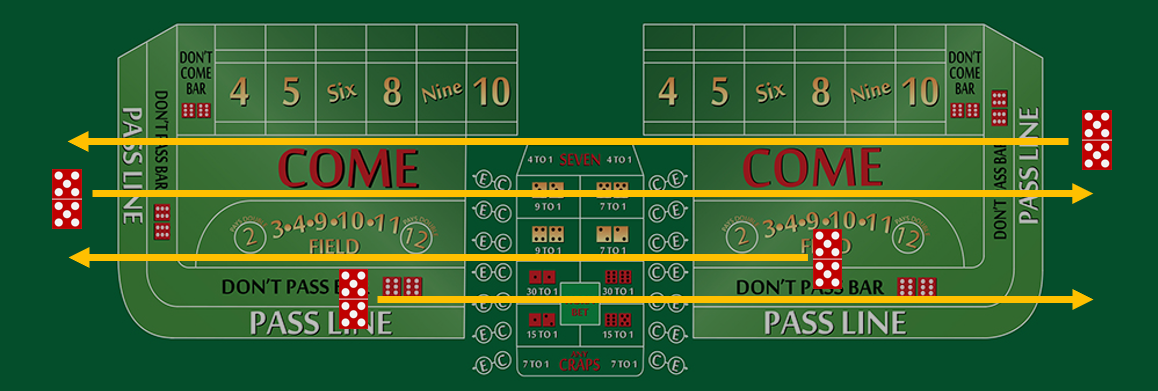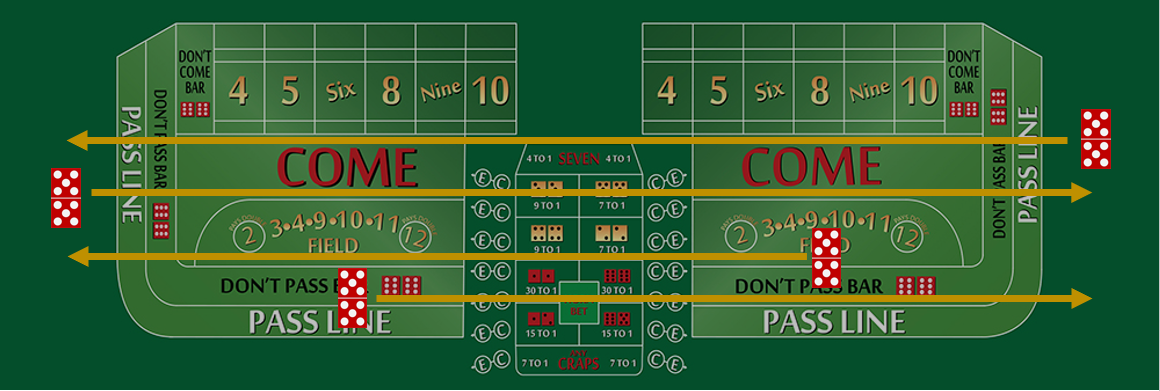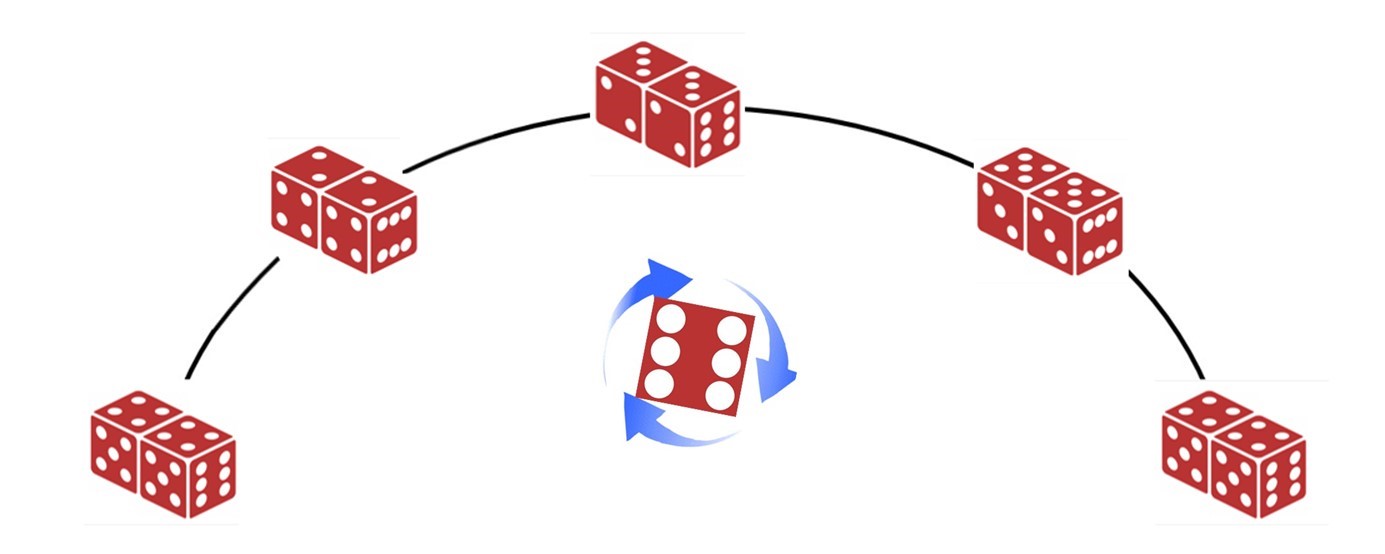Learning to execute the toss, correctly and consistently, will be the toughest part of your development along the journey to becoming a Controlled Shooter. This is where most of your practice time will be spent and this is also where many give up their quest, as there will be times when you feel that it will be virtually impossible for you to conquer this task.
Have faith. I was at that point myself. It was at least a couple of weeks before I was able to achieve having the dice fly through the air symmetrically. Try not to give up. Learning something new takes time, effort and commitment. With continued practice, you too will be able execute the toss that appeared too difficult when you started.
All casinos require that you toss the dice across the table and hit the backwall diamonds before coming to rest. Failure to hit the backwall can result in the dealer calling ‘no roll’ and needing to re-roll the dice. The intent of this rule is to ensure randomness of the dice rolls and to counter the efforts of Controlled Shooters.
To comply with the casino rules and still maintain a level of control over the outcomes of the dice, Controlled Shooters take a number of steps in their toss to minimize the effects of the casino rules.
Once you’ve set the dice and properly gripped them, an effective controlled toss involves;
- Select your landing zone across the table
- Select your travel path
- Know your stance at the table
- Dice and Hand Alignment
- Delivering the dice across the table by having them travel symmetrically through the air, in an appropriate arc to maximize control upon landing
- Providing enough backspin to create enough centrifugal force to maintain the dice on-axis after touching down
(While you would NEVER practice and develop your skills at the casino, the guidance below is based on a casino environment so you have the right mindset when practicing at home and understand the role of each of the components involved in executing the toss)
HOW TO EXECUTE THE CONTROLLED TOSS
Executing an effective controlled toss requires that each of the several steps involved are performed correctly and consistently. We’ll walk through each of the steps below.
LANDING ZONE
Selecting a landing zone should be conducted long before you ever get the dice. This will give you enough time to scope the opposite side of the table to find a landing zone that fits your control style.

One of the reasons that you should play a nearly empty table (aside from getting the dice back quickly) is that you have a lot more flexibility in the available areas to select from for your landing zone. Additionally, you want to have the room to execute your throw as comfortably as possible. (Difficult to do if your shoulder to shoulder with the players on either side of you).
In selecting a landing zone, you not only need to think about where you’re going to land the dice, but also, where the dice will likely go after hitting the table and the backwall. Any interference from bets on the table, odds, etc. is going to have a negative impact on your ability to influence the outcomes and create more random results if your dice start hitting chips on the table.
In the example on the right, I personally would not play at that table to utilize my dice control skills.
- It would take me 30 to 60 minutes to get the dice back limiting my opportunity to ‘cash in’
- It would require re-establishing my tossing rhythm due to the amount of time between being the shooter.
- I’d likely be crowded and not comfortable where I’m standing to execute my toss
- My landing zone would be extremely limited
- There will likely be a lot of interference from the chips on the table
On the other hand, the example on the left;
- Allows me to select the landing zone that is most effective for my tossing style
- I can feel confident that my dice will not experience any interference after landing, and
- I likely have plenty of room to be comfortable from where I’m tossing
In any event, selecting the landing zone you’ll use to execute your control skills needs to be conducted long before you get the dice and should even be used to determine, whether or not you’ll play at this table.
TRAVEL PATH
Now that you’ve selected your landing zone, you now need to select the travel path you’re going to use to deliver the dice to your landing zone. Determining your travel path also needs to be conducted prior to having the dice slid to you.
(Once you get the dice, you only want to have to focus on the set, grip and toss. All other decisions have already been made.)

You want to deliver the dice in a straight line from your launching area to the landing zone to avoid any angles that will create abnormal bounces off the table or backwall causing one die to interfere, or crash, into the other die.
The good news about the craps table, is that there are plenty of travel paths (runways) to use printed directly on the layout.
As in the examples above, regardless of whether your shooting ‘right to left’ or ‘left to right’, or from either of the backwalls, you can choose virtually any line leading to your landing zone to use as your runway.
By using the runways printed on the layout, it will not only provide you a clear and distinct path to your landing zone, but if you follow the dice along that path, you’ll clearly see if your dice travel ‘off-runway’ and any adjustments that need to be made in your toss.
STANCE
Before we move on to the next component, I wanted to cover your stance at the table when executing your controlled toss.
It’s important that your dice toss has a light touch and is consistent from toss to toss. To accomplish this, we need to take as much body and major muscle activity out of the equation. To do that, follow the guidance below, both in your practice sessions and in your live casino sessions.
90% on your lead foot – Place 90% of your weight on your foot closest to your landing zone.
The body’s natural tendency is to sway from your current location toward your landing zone. This creates a lot of body movement that will interfere with both your ‘soft touch’ and consistency in your delivery.
By placing most (90%) of you weight on your lead foot, you’re eliminating most, if not all, of your sway forward.
Lean against the table – Once you’ve placed 90% of your weight on your lead foot, lean your body against the craps table. In conjunction with your leaning forward, placing your weight against the table will virtually eliminate any lower body movement from impacting your toss.
Place your opposite hand, elbow or forearm on top of the rail – This creates another barrier to lower body movement impacting your toss and now also stabilizes much of your upper body and shoulder movement, which can also negatively impact the consistency and accuracy of your toss.
Your goal is always to allow only your hand, wrist and arm to be involved in tossing the dice to your landing zone.
DICE/HAND ALIGNMENT
You’ve set and gripped the dice, now your goal is to align the dice and your hand to the travel path and your landing zone, in preparation to ‘launch’ the dice.

Errors in alignment here, will result in exponential issues by the time the dice travel to the other side of the table and hit your landing zone.
Once you’ve gripped the dice, visually follow the path back from your landing zone, through your travel path and place the dice on the table forming a ‘straight line’ from start to finish. This will give you the best opportunity to eliminate any unwanted ‘angles’ to be created in your toss.
The dice should be parallel to the back wall and perpendicular to the side wall. It’s also important that the dice remain perfectly parallel to the table bed so they are not tipped to one side or the other. That’s why you’ll often see Controlled Shooters launch their dice from the table rather than lifting them up prior to tossing.
DELIVERY
The dice are aligned on your travel path and you’ve locked in on your target. It’s now time to deliver the dice to the opposite side of the table while maintaining influence on your desired outcomes.

Using your grip mechanics, begin moving your wrist, hand and dice down the travel path as you launch the dice into the air toward your target. You want the dice to have only enough forward energy to reach your landing zone and come to rest as quickly as possible with the least amount of movement possible. The more consistent you become on executing the toss correctly, the more consistently you’ll achieve your intended results with the least amount of randomness.
KEYS TO A WELL EXECUTED TOSS
- Your hand movement in launching the dice into the air should be smooth and not jerky, picking up speed from start to finish
- Just like a pitcher in baseball, follow through and continue your hand and arm movement even after the dice have left your hand
- The launch angle of the dice should be between a 30 to 45 degree angle dependent on how far you are from the backwall
- The further your dice need to travel, the steeper your launch angle will need to be to reach your target with the least amount of forward energy
- The dice should travel through the air symmetrically, as though they were glued together and moving in unison
- There should be less than one inch horizontal separation between the dice at the time they land to maintain influence on the results
- The vertical separation between the two die should be as close to zero as possible. Vertical separation will cause unwanted additional pitches on the die and less consistent or desired results
- Appropriate backspin will be critical to both the flight of the dice as well a their landing
- The example above demonstrates the backspin direction of the dice if it were traveling from right to left
- Backspin provides a gyrational force to the dice, keeping both die stabilized through their flight
- Backspin functions as a brake to help disspel any remaining energy from the dice when they hit the table
- The number of rotations from launch to landing is dependent on the length of the toss, the table surface and bounciness of the table.
- Start with 1 ½ and 2 ½ rotations until you learn the appropriate number for your individual toss
- The dice should land flat to the table on your landing zone and not on the edges of the either die
- Flat landings give you the greatest amount of stopping power
- Landing on the edges will shoot the dice in the opposite direction
- Land on the right corner, dice will shoot to the left
- Land on the left corner, dice will shoot to the right
- In landing your dice, you’re attempting to coordinate 3 separate energy forces to provide a soft landing that dispels any remaining energy in the dice
- Forward Energy – should be just enough to reach your target landing zone
- Descent Energy – based on the height of the flight arc, the downward pressure of the dice descending helps stamp the dice into the table, reducing forward energy
- Backspin – applies a braking action to the dice as they touch down on the table
- Occasionally, you’ll see the dice ‘stop’ and appear to ‘stick’ to the table when they hit as if they landed on a film of glue. While appearing totally unnatural, it’s actually the effect of the 3 forces above being perfectly administered
- This level of perfection is not necessary in controlled shooting, is very difficult to achieve, and even if you could, would count as a ‘no roll’ due to the dice not hitting the backwall
- It’s awful fun to see when it does happen though!
Like learning any new skill, developing your Controlled Shooter skills will appear difficult at first. Practice, practice and practice. Not only will it get easier, but you’ll probably even surprise yourself at how good you’ve become.
Learning to control (influence) the dice at the craps tables has been one of the most emotionally and financially rewarding endeavors I’ve ever taken on. Hopefully it will be for you too.
For more information on becoming a Controlled Shooter and flipping the odds on the casino, check out…
.

Craps Secrets has merged with the Black Chip Club
Please visit us at BlackChipClub.com
.
*****************
If you have any questions, suggestions or recommendations, feel free to leave them in the comments section below.
In the meantime…
BEST OF LUCK AT THE CASINOS!!!




11 thoughts on “Craps: How to Execute a Controlled Toss”